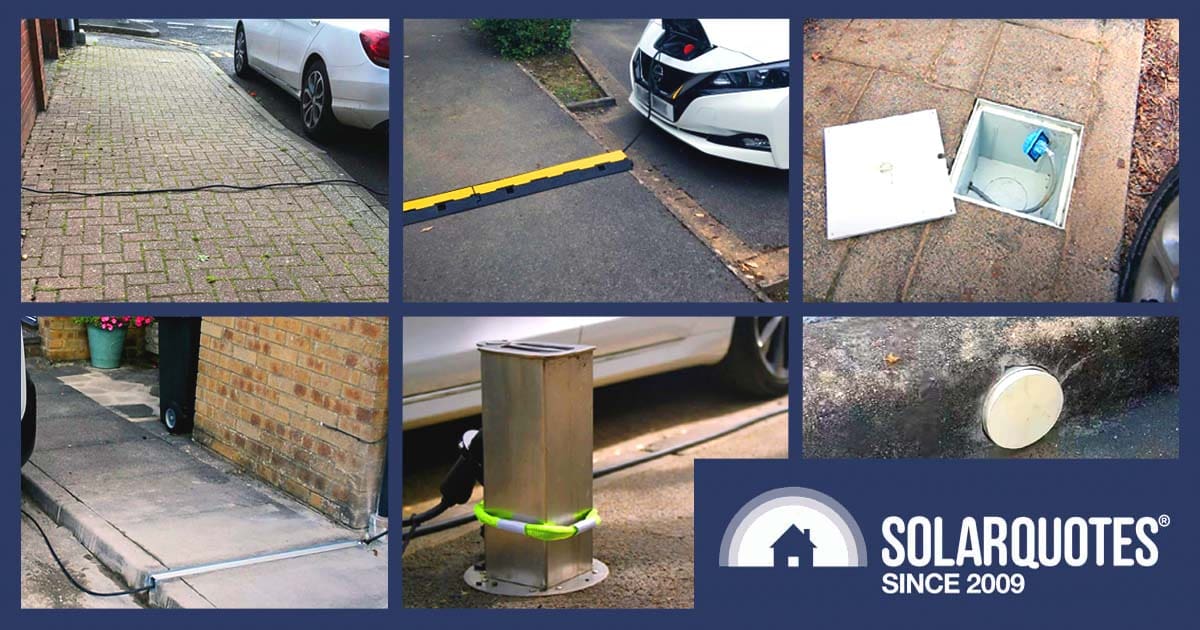
Living in the city makes it hard for electric car owners without off-street parking. It’s tough to find a place to charge, dissuading many inner city dwellers from buying electric cars.
Forums and social media show passionate and divided opinions about what’s acceptable for urban EV owners who need to charge on the street and the answer may well come from overseas.
The Cable On The Pavement Problem
Can you roll out the cable from your home across the footpath and plug it into an electric vehicle on the street for a couple of hours or more?
Sure! Plenty of of people are doing it. But see how long you last before you get a complaint from an angry neighbour or a visit from your local council ranger.
Few authorities would see this as acceptable. State governments Australia-wide have legislation allowing local councils to make by-laws relating to safety and other issues on verges, crossovers, and thoroughfares on public land. Even if no such law or policy exists, a complaint would trigger the relevant department to take a look.
Erring on the side of caution, only a brave council officer will expose the city to potential litigation, and some would say rightly so. It’s hard not to argue that, in most cases, this would be inconvenient for people with accessibility issues and a possible trip hazard, or worse, a dangerous electrical hazard.
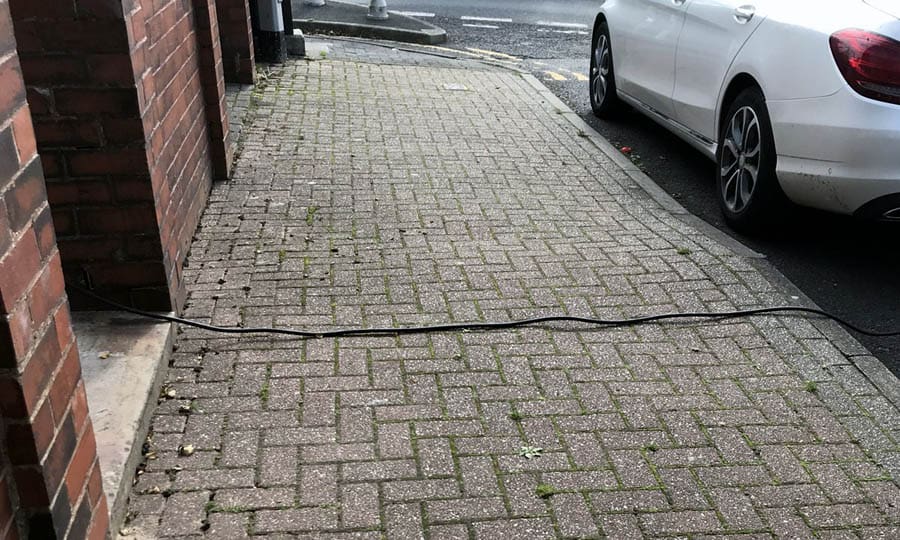
You wouldn’t want to make a habit out of this sort of thing. Image: Charge Gully
Cable Covers
Many EV owners have tried to do the right thing by running the charger cable under a cable cover or mat and making everything highly visible and as safe as possible. Although commendable, it may not tick all the boxes that make this a viable solution. Any deviation to the height of the thoroughfare surface would still be a trip hazard for the visually impaired and challenging to navigate for prams and the like.
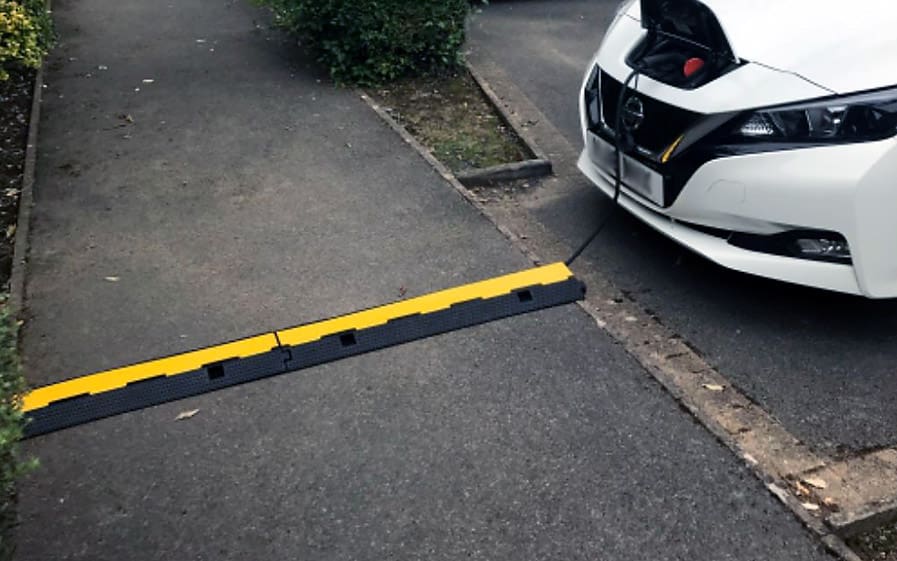
A cable cover over the charging cable is still a trip hazard for some people.
Hanging Cables Overhead
Sorry folks, that’s a big no-no. Some inventive EV owners have provoked social media backlash by hanging cables out of windows, across trees, and on street signs, desperately trying to get an overnight charge. Unless done professionally, it will likely violate council safety policy and Australian electrical standards.
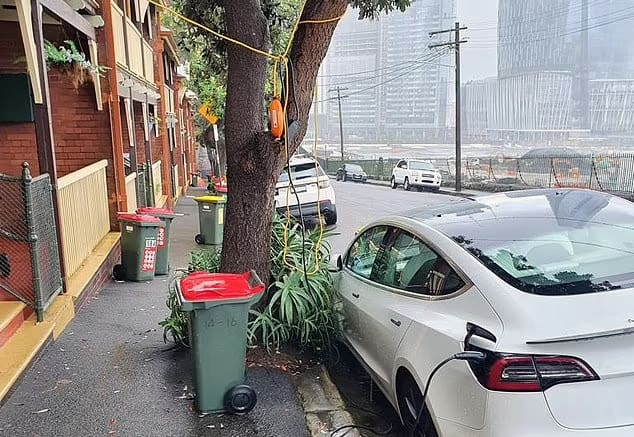
This pic has been doing the rounds over the past year, and drawing the ire of the anti-EV brigade.
Don’t Try This At Home Kids
In this video, a YouTuber proudly shows the world how he took matters into his own hands by digging up his verge footpath and burying an enclosure similar in size to one of the concrete slabs, which now houses one end of his charger cable next to the street. Every way you look at it is an accident waiting to happen. He cheekily names his channel “PowerElectronicsBlog” but has no clue about the dangers of electricity.
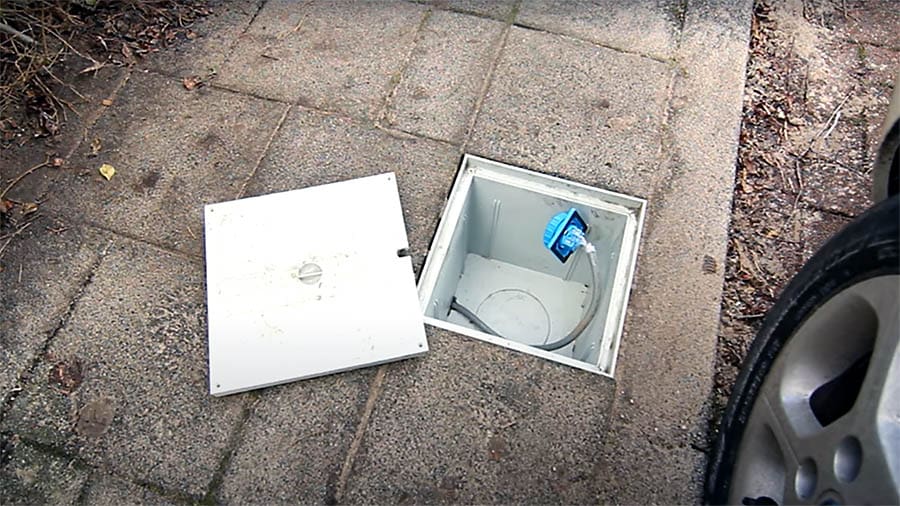
EV charging YouTuber style: Don’t try this at home kids, it won’t end well.
Is This One Legit?
And in another video, Matthew demonstrates how he used an old preexisting drain pipe to run a cable from the EV charger on the property, underneath the footpath, and onto the street to charge an EV. Matt is not without his detractors, who have pointed out in the comments that it may not be an all-weather solution! What do you think? Is it legit?
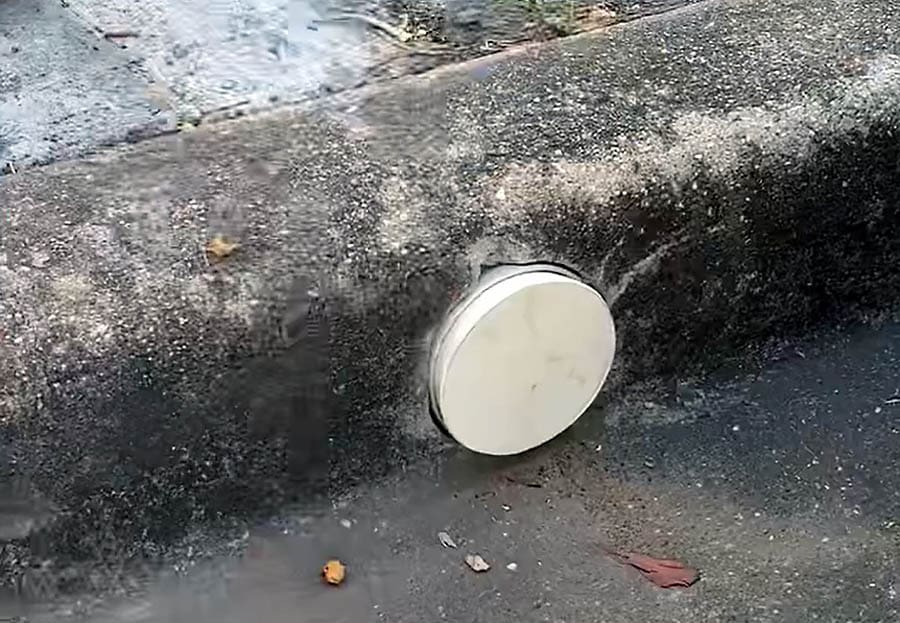
Just remove the bung, and it’s a good use of an old drain pipe, or is it?
On-Street EV Charging Solutions
So if you can’t do this and you can’t do that, then what the bloody hell can you do if you want to charge from home but don’t have off-street parking?
Solution #1: EV Cable Channel Or Gully
Although yet to be available in Australia, there are at least four UK companies1 manufacturing and offering the installation of a channel or gully set into the pavement where a user can run a cable from their property across a thoroughfare to the kerbside. The channel’s top sits flush with the pavement, allowing people to walk past safely without even noticing.
I wouldn’t take the angle grinder to your pavement just yet, though, because the whole thing has to get the green light from the relevant local council. These companies can help you liaise with the authorities (if you live in the UK.)
I’m sure it’s only a matter of time before this idea catches on in Australia. Although maybe not everyone agrees, my thoughts are that this will be one of a suite of solutions for urban street charging here. It’s not bulletproof, though, as there may be drainage or maintenance issues, and it must be electrically safe in case of a damaged charger cable.
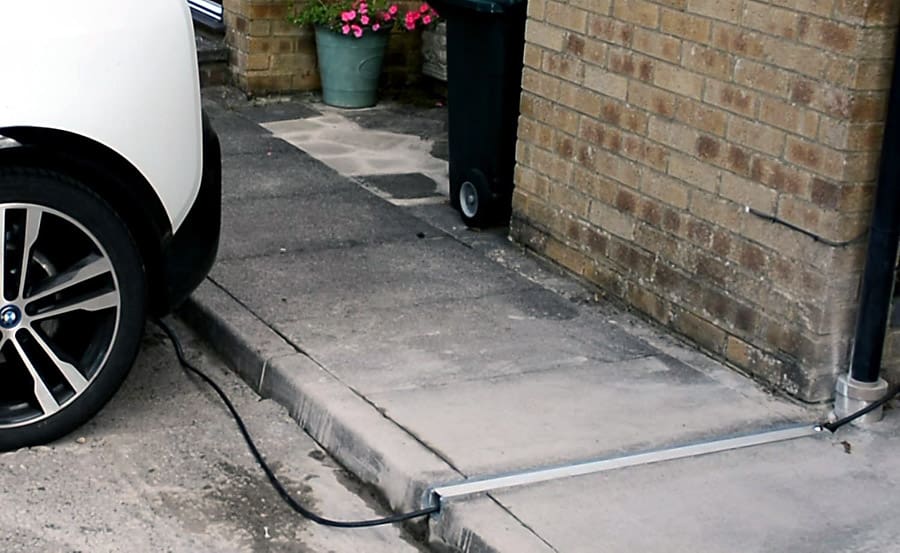
There are a growing number of EV charge gullies and channels available in the UK. Why aren’t they doing it here? Image: Charge Gully
Solution #2: Private ‘Pop-Up’ Kerbside Charging
Here’s something you can do if you’re cashed up and live in the right suburb. Aussie start-up Kerb Charge has developed a first-of-its-kind ‘pop-up’ charger that they can install on the pavement outside your house. The City of Port Phillip has trialled these 7 kW units, and other municipalities are following suit.
Among the drawbacks is the stinging $6,000 price tag, with no guaranteed access to the parking spot in front of your house. It may be why they’re not flying off the shelves, with reportedly fewer than a handful of applicants signing up for the City of Port Phillip trial. Indeed, a well-thought-out business model might be needed to make these mainstream.
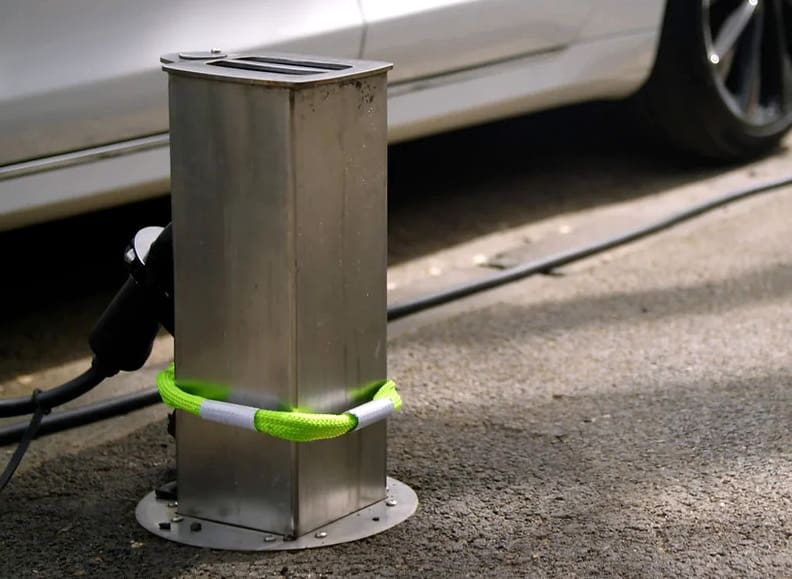
Kerb Charge – a great product, but is it cost prohibitive? Image: Kerb Charge
Solution #3: Public Kerbside Chargers
Two schemes are currently running, aimed at increasing the number of AC chargers available on the streets in urban areas of New South Wales. Buy a lottery ticket if you get one in front of your place. For the rest of us, as EV numbers increase and owners start making noises, authorities will be forced to be more proactive.
- ARENA funded – Intellihub Street Power Pole EV Charger with Grid Integration
- NSW Government – Electric vehicle kerbside charging grants
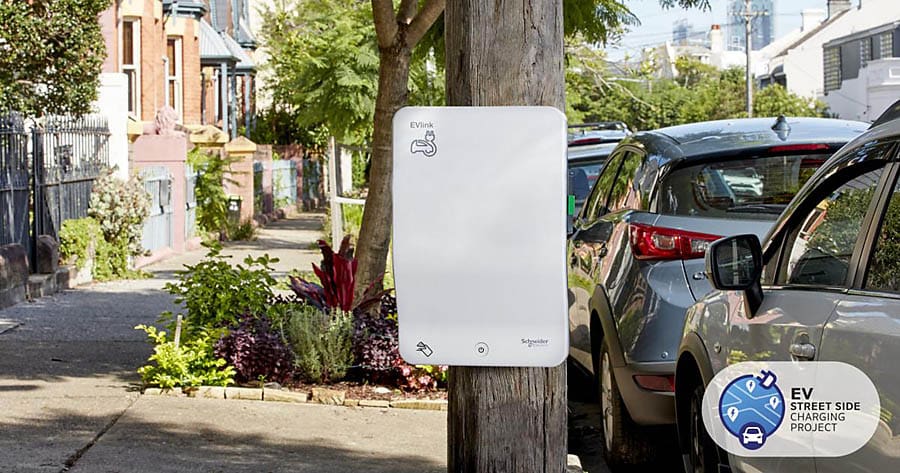
EV streetside charging project in NSW.
Other EV Charging Solutions?
From where I’m standing, there are few other options for on-street charging. Most EV owners prefer to do it at home, so the usual ‘charge while you do the shopping’ and ‘charge at work’ routines are often brushed aside because, well, they’re already doing it.
Beyond the convenience, there’s something empowering about telling those oil companies to take a hike and power up your car with renewable energy from your house. It’s a fundamental part of what makes owning an EV so rewarding. Using your home-grown solar to fuel up is part and parcel of the experience.
Until this is sorted, some potential buyers are holding off purchasing an EV, and that’s not good news for the widespread adoption of sustainable transport. If you have any other bright ideas for street charging or some stories to share, drop them in the comments below. Your input could spark the next solution.
Update 16-2-24: A reader notified us about this great solution for “cable over the pavement” EV charging called ChargeArm. It works up to a maximum span of 2.4 metres. Any budding entrepreneurs out there want to become the Australian dealer?
Footnotes
- Charge Gully, Pave Cross, Gul-e, and Kerbocharge. ↩

 RSS - Posts
RSS - Posts



There is a new Australian system that, in essence, uses metered 240V outlets for trickle charging an EV. The EV owner pays the company, Alchemy, directly and the building owner is not charged. The main use is likely to be in strata units.
https://www.alchemycharge.com.au/
Of course trickle charging is not very practical for high-usage EVs but it might be feasible for overnight partial charging of low-usage EVs.
Interesting idea. A good solution if you already have sockets installed in the right place. Shame about the marketing BS on the site. e.g. “making it an effortless addition to any space.” I’m not sure some of those powerpoints with concealed wiring were effortless for the sparky involved!
For most EV installs, the biggest labour cost is running the dedicated cable. Once you’ve done that, a proper EV charger is almost as easy to add as putting a socket on.
I’m testing another solution in Sydney – Bow Charging – that connects EV drivers with no home charging to rooftop solar homes with charge points.
Drivers benefit from a cheap and clean charge near their work or home. Solar homes benefit from significantly greater solar income than grid exports.
More info at http://www.bowcharging.com for those interested, feedback welcome!
Only glanced at the website, but I’m not sure how long the alchemy business model would last into the future if there’s mass EV uptake. Would seem easier for strata to get any sparky to run cable from the meterboard to every resident’s parking spot in one go and install a lockable outlet for each. Supposing cables can run along the car park ceiling (do they have to cut them in by regs?) or there’s no other technical drama I’m not aware of.
Or maybe that’s just what they are planning to become the go to company for, but presenting it as ‘smart charging’ does suggest over complication or a bit of a premium could be charged, which could be fair enough if they are taking the costs of doing business with strata properties in a new market (going by the number of ‘characters’ who never agree on our strata). But ‘smart charging’ solutions for 2.4kW outlets? It would even seem a stretch to share a 7kW charger with a few others on a daily basis, but much more doable than 2.4kW.
Inner West Council in Sydney allows kerb side charging using a cable cover secured at each end. Approval must be applied for and displayed on the cable cover. Not many at this stage but becoming more common.
That’s great news Rob. Thanks for sharing.
That may change when someone trips over one and crashes face down like my wife did.
Kerbside obstructions are the bane of the disability community. For the blind and wheelchair bound they’re a real pain.
Re: allowing charging via a covered cable: that was only a trial program by the Inner West Council, and they’ve cancelled it now due to safety concerns.
https://au.news.yahoo.com/aussie-council-walks-away-from-dangerous-electric-vehicle-trial-011918038.html
The council is apparently developing more public EV chargers (or facilitating charging networks to do so), e.g. in council carparks – but I haven’t seen much in the way of actual installations yet.
The concluding paragraph nailed it. EVs are really best for those who have a residence with a driveway, and preferably a garage, where you can charge from your own solar energy or can access ultra low offpeak rates.
First thing we did when getting a shiny new EV was clean out the garage that hasn’t been used for cars for 20 years! Energy independence is good but transportation independence is amazing.
These recommendations may work , if you park in front of your own house . If you have park down the street or across the road ( eg street full of home units and apartments) , well you’re charged deprived . I have always stated EVs are great in a perfect world , eg charge in your own driveway and top up each night and pop down to shops or train station, anything else and they are totally inappropriate. Eg Holiday driving , public charging, towing , wasting time driving around looking for available public chargers, Pre warming the battery you want to charge, you can’t just pop in for a top up at public charging stations, EV’s are really good for a few when all the planets line up . Not for the majority, Remember the average Australian cannot afford an EV
Out of interest, AJ do you own an EV or have you ever spent a few days driving an EV? Almost every problem you conceive is not a problem for any EV owner I know. I have been an EV only household for over 4 years. But, yes I do have a driveway.
I have written many comments over the last few years about EV.s . Yes the technology is great , the acceleration is great , it’s just the infrastructure around having to recharge the cars . It’s just not practical for a lot of people and the cars are expensive.
Thoroughly agree Finn. The problems that AJ sees are not seen by EV owners.
It’s not seen by existing EV owners because they are a biased sample. EV owners are predominantly people who do not face the challenges of charging because they have a parking space/garage and an electrical supply available. They also likely own their home and can make the necessary changes.
If you do not have a dedicated parking space then it most definitely is an issue. Likewise if you rent. Public charge networks are atrocious in their available and reliability.
I am fortunate as I have a garage and an EVSE, so it’s easy for us but this is not the case for many. When I travel on our highways and regional routes, it’s always a stressfest hoping that the next charge stop will actually be working. I’m yet to have a road trip without a public charger problem.
Rule # 5 Finn,
The topic is curbside charging, your copious rooftop solar and private driveway are not what is being discussed.
I have borrowed a Volvo wagon EV and my experience mirrors yours, however I have a 9.4kW pv system, 3 driveways, and a 3 car garage (no I did not charge the car in the garage because my neighbour burnt down his garage charging an E bike in it) I’m also retired so could pick and choose when to plug it in.
But what about my 6 kids? 4 in Sydney, 1 in Canberra, and 1 in Melbourne.
3 are buying apartments, and have no ability to charge even though 2 of them have underground garages. 2 are renting with no off street parking, only one (Canberra) has his own garage and driveway, but he can’t afford solar, never mind an EV.
So for the privileged/relatively wealthy few, with specific needs, an EV makes sense, but what percentage of the Australian population lie within these rather narrow confines?
Uptake of EV’s has slowed, all the early adopters now have theirs, so sales figures moving forward will be a better indication as to how well or not they are being received.
My time with the Volvo was interesting, and for me not at all disappointing, however will I buy an EV?
I drive approx 100-150k’s a week, and get 700k’s range from my diesel BMW, which I own and costs about $140 to fill up from empty, it’s 9yrs old so depreciation is negligible.
EV depreciation however is astronomical, and will only get worse as battery tech improves and cheaper EV’s become readily available.
I could sell my car tomorrow and still get reasonable money for it, how much would a 9yr old EV be worth in 2033 I wonder.
So financially it would be idiotic for me to switch at this point in time.
As for saving the planet, when COP yields more than back slapping, and meaningless rhetoric, I’ll rethink my position.
Cheers Grahame
Grahame – you seem like a decent bloke – 6 kids and they’re all doing pretty well but you’ve kind of missed the point of the article, haven’t you? It wasn’t saying that what we have now is ideal or even practical. It’s trying to discourage people from doing silly things. But I’d dispute that things won’t get better for apartment dwellers and renters. It will take some time – don’t forget – EVs with a low enough price and long enough range have only really been around since 2018.
And if depreciation is as big a problem as you paint it to be, shouldn’t that be good news for your son in Canberra – pretty soon he will be able to afford his own EV… except dammit I just had a look and the only 2nd hand EVs under $20K in Oz are low range Nissan LEAFs, 1 iMiev and 1 iMiev minicab (don’t buy any of those). Why hasn’t Australia experienced the massive depreciation you talk about? Because Tesla, who are driving price reductions started pretty low and pretty late in Australia. The cheapest model 3 I could find used (in Sydney) was $41,989 for a 2019 vehicle with 70,000kms on the clock. That’s a fairly high mileage, over 4 year old vehicle that’s retained over 65% of it’s new value and that doesn’t seem outrageous to me.
“I drive approx 100-150k’s a week, and get 700k’s range from my diesel BMW, which I own and costs about $140 to fill up from empty, it’s 9yrs old so depreciation is negligible.”
And no one is advocating that you get rid of it. However, nothing you said there precludes you from getting an EV and experiencing something better. Not trying to save the planet but for commuting, EV’s beat ICE every time. IMO.
How much would wan ev be with in 2033 ?? Well, the important question is how much will petrol cost in 2033?? Because if petrol is $5 a litre in 2033 then the 9 year old ev starts looking more attractive
And how much will electricity cost? It went from 27c/kWh to 32c/kWh in July 2022 then to 42c/kWh in July 2023. How much will it go up this year?
The shame of it is AJ that there is an essence of truth in your opening statement. Everything else is a bit misinformed maybe by the continual talking points you see the anti-EV brigade peddling.
“Holiday driving , public charging, towing , wasting time driving around looking for available public chargers”
Obviously you can use your EV for holiday driving as many Australians do. Public charging is probably ahead of demand at the moment in Australia but it will reach a tipping point as more and more EVs hit the road. Over 80% of EV drivers charge at home so they will never see the same demand as petrol pumps. if you’re referring to uptime and tap and go access then you have a point.
“Pre-warming” the battery- “you can’t just pop in for a top up at public charging stations”
Of course you can. Most modern EVs that support that kind of battery preconditioning do it automatically when you navigate to a DC fast charger. Pre-conditioning is only necessary when DC fast charging – but in mainland Australia where temperatures rarely drop below 0degC there’s no problem plugging into a DC fast charger cold -it would just not be optimised.
“EV’s are really good for a few when all the planets line up . Not for the majority, Remember the average Australian cannot afford an EV”
Well the buying public disagrees with you. The best selling car in Australia last year would have been the Model Y were it not for the humble stink bug.
There are some things you are correct about:
1. Towing – EV’s are not as good as diesels for hauling large loads like big caravans. Fine for the tip run.
2. Kerbside parking – yep, it’s a problem with plenty of potential solutions as most kerbs already house electrical infrastructure. In fact I think that’s what this article is all about.
3. Unit/Apartment parking – yep, once again the right incentives need to be put in place to get landlords to install infrastructure.
Hi AJ,
I just bought a perfectly good EV for $4000. I’ll send you the link once the article is published. It answers a lot of your concerns with real world reasoning. Standby for updates in the coming week.
I was recently traversing the narrow side streets of Richmond, Victoria. No garages around. Saw electric car being charged on the street with the cable run through the stormwater drain under the narrow footpath.
‘Lucky’ for the owner of the electric car, they could do that, at least on the day I passed by. Don’t think the local council would be terribly happy with that arrangement, even though the cable was not a tripping threat.
If you live in a street with no driveway then the chances are most of the vehicles are small ones. Can you find a small EV except for the Mini or Fiat 500 (is it even here yet)?
For small EVs, look at the BYD Dolphin or MG M4. Both are compact cars (that fit in our short garage)
FYI – Mini EV, you can get it but it’s not that small! Mini’s no longer live up to their name.
Services such as water, electricity, gas, and sewage already run under the pavement, so what’s the problem with adding an EV supply? Obviously this would have to be done properly. As for the kerbside outlet, kerbside already has power poles, parking signs, lamp posts, etc. so EV outlets would hardly be an obstruction.
We installed a 32amp power point low cost charges overnight just drove to warnambool stopping at evoca for lunch used evie charger $13 which took us to killarny beach 38% charge left our lr model3 loves long road trips .Whilst driving observed power lines many with obviously underutilised transformers great opportunity to install low cost charging opportunities.
Seems like part of the problem is that car ownership is increasingly incompatible with dense city living. The streets are too narrow for cars to park, don’t offer EV charging, and garages are either not provided, not provided in sufficient number, or filled with stuff that prevents use by vehicles.
Is private ownership of EVs simply part of a trend towards another model? The World Economic Forum is certainly famous for its idea that private ownership should be slashed by up to 90%, with shared autonomous EV ‘taxis’ used instead.
Indeed Singapore is one example of a ‘country’ where the right to own a private vehicle is a very very expensive privilege!!! A 10 year Certificate of Entitlement for a basic car is close to the median annual household salary. A small, government-subsidised flat costs half that!
George – you aren’t really comparing Singapore with Australia are you? They are both islands but even a modicum of research might have picked up a few differences… there’s a reason car ownership is expensive in Singapore and why everything is a lot more expensive than most Asian countries.
Of course you have a point about private car ownership – I know plenty of young people who have chosen a local urban lifestyle over car ownership. Public transport in Sydney has been radically improved from when I was a kid.
Don’t all these schemes rely on the owner being able to park outside his own property? If I park outside your house am I going to be harassed to move my car so you can park and charge. To be honest, I’d be tempted to take an axe to a power cable laying across the footpath.
Nothing that getting on with your neighbours can’t solve. Threats with axes probably are not helpful in that regard. 😬
You just need to read the number of posts on the Whirlpool forum relating to complaints people have about others parking in front of the complainant’s house to see that it’s a minefield. But a cable across the footpath is not on. My wife tripped on a footpath slab that had lifted, she went down hard and smashed her face badly, also destroyed a $1,000 pair of spectacles. Fortunately, Penrith council paid for new glasses and fixed the path within days.
The support infrastructure is certainly limited and lacks uniformity in many aspects, but it is expanding VERY rapidly, as are the number of EV’s.
Petrol stations have been around for over 100 years, modern EV’s about 10, so one can’t expect EV infrastructure to match ICE stations convenience for a few more years yet.
Some Unit dwellers certainly have a challenge to have their own charger installed and will have to use the local public chargers while shopping or whatever, as many do now. Many EV owners have basement carparks, and the Body Corporate will soon be under pressure to install whatever is required. Locals soon know where to find them, while travellers do need to search, but there is already a surfeit of Vendor Apps vying for the EV customers, that provide maps etc.
Yes, at the moment the chargers are tucked around the back/down the alley/in the corner of the UG carpark, & maybe hard to find. In another year or two, I predict many service stations will have multiple DC chargers necessary for a quick charge (if not the servo will disappear within 10 years), as well as shopping centres, where fast EV chargers are the perfect attractor to get people into the centres – “stuck” for an hour or so in the shopping centre – that is Nirvana for the centres who spend millions on advertising to achieve just that.
I don’t believe affordability is a real issue for new car purchase (as shown by the sales) when you consider the cost of a decent spec ICE vehicle. A look in any carpark at the lineup of “flash” vehicles, will show that a fair percentage of cars in the car park cost more than the cheapest EV (which have ALL the bells and whistles of top spec ICE models).
BTW, “Warming the battery” I have never heard of, and not required with my car. (The cars onboard AC unit services the battery as well, and warms or cools as required).
If a person who has no charging point has a friend with a type 2 charger it may be possible to use the friend’s type 2 charger every second or third night and pay the friend for the electricity used. Alternatively, if the person has a car parking space at work it may be possible to have a type 2 charger installed there.
Charging over sidewalk:
https://chargearm.com/en/
Andrew, this looks very good. I wish I had of known about it before I wrote the article. It might even be possible to install something like this on a private property without involvement from the council.
“In this video, a YouTuber proudly shows the world how he took matters into his own hands by digging up his verge footpath and burying an enclosure similar in size to one of the concrete slabs, which now houses one end of his charger cable next to the street. Every way you look at it is an accident waiting to happen. He cheekily names his channel “PowerElectronicsBlog” but has no clue about the dangers of electricity.”
To be fair Kim, he does say in the video the socket is not properly housed yet and he was just testing it. Given he does that my only real problem with his install was the lack of drainage. Those IP socket and plugs are not rated for submersion and potentially that whole box could fill up with water. Power electronics usually refers to semiconductors (eg MosFETs and power circuits) not mains electricity.
Hi John. I can’t agree with you on this one sorry. There are multiple safety issues that this DIYer seems oblivious to. As well as the IP rating not suitable for immersion, which no doubt will happen as the box fills up with water, he has buried the cable in the ground without mechanical protection (no conduit). For that alone we should subject him to torture by electrocution, as he his potentially exposing other people to. Also I doubt the lid on his enclosure is rated for the load of many an innocent passerby. Someone’s foot is going right through that thing. When it comes to electrical safety, I take no prisoners. This guy needs to be called out. He should stick to what he knows.
Of all the options mentioned I think shareable kerbside chargers dotted around areas of suburbs without much off-street parking and selected public locations is best if accessible a) to registered residents of the council area without off-street parking, and b) anyone else at a higher rate, so long as residents get exclusive access to advance bookings? I reckon this might combine the best of local charging for people without chargers, and affordable AC destination charging for people out and about.
That would make good use of the installed infrastructure, which if close to $6,000 a pop would be cheaper by orders of magnitude than DC chargers to install and maintain.
At Everything Electric the other day one of the speakers said only 70% of Australians are currently in a position to charge privately, so if true when EVs become cheaper to own than ICE in every respect in a few years this will also become an equity issue that governments have to solve. Either the kerbside idea or a govt managed plan to install enough AC destination chargers at convenient places where people park up all over Australia (shops, car parks, public facilities) will be needed, or a mix of both. The DC fast charging networks will never provide guaranteed, affordable and convenient charging for all in a spread out country like ours, and why should they as businesses?
I’ve read a heap of blogs about “sprinkling EV charging points” around the suburbs, to allow easy access for those who may have to park on the street, can’t install PV, or work during the day so are unable to use local PV – etc., etc.
But most appear to miss an unfortunate reality.
We live in a cul de sac – with ~33 other house – all with garages and driveways – most with 2 or more vehicles. The network for these 34 houses is fed from a distribution main, via a 50 kVA transformer.
So, if 7 x 7 kW fast chargers were switched on at night – there would be no capacity to run anything else. Or 1 x 50kW supercharger.
Put in a bigger transformer I hear! But no, I know the voltage drop from the sub-station is already marginal. So let’s increase the capacity of all the distribution mains ($$$$$).
But I fear the sub-station would then not be up to the job – more $$$$$$$. And the transmission lines.
Of course in the fullness of time all this infrastructure will be built out – as did the liquid (and gaseous) fuel networks – but we are miles away from that presently.
I fear we are putting the cart before the horse.
Hi Ian,
SAPN are already planning to have double the energy throughput on the same infrastructure as we electrify everything and ditch fossil gas. If 33 other houses all had a shower simultaneously there wouldn’t be enough water. If 66 vehicles all parked on the road because their garage is full of cr@p there wouldn’t be enough space. What we have to realise is that it’s shared infrastructure.
We don’t brimfull cars with petrol daily & not everyone needs to charge an EV fully all the time either.
The answer is actually to have cars plugged in during the day.
Wherever they’re parked, whenever, just pull up and plug in. Even if it’s just on a 2kW (10km range per hour) general power point, we need to be soaking up sunshine when the price already goes negative. With a tank full of fuel you can drive home and siphon some off to cook tea…
There’s some education and a cultural shift needed.
I’m testing another solution in Sydney – Bow Charging – that connects EV drivers with no home charging to rooftop solar homes with charge points.
Drivers benefit from a cheap and clean charge near their work or home. Solar homes benefit from significantly greater solar income than grid exports.
More info at http://www.bowcharging.com for those interested, feedback welcome!
Hi guys,
Our business, ChargePost has been manufacturing a unit that connects onto existing lamp posts or power poles.
I want to share info but mindful of inappropriately using this forum.
We are based in Melbourne and Sydney and working with many local councils and power distributors.
One other point worth remembering – if you’re fortunate enough to live in an inner-city suburb with high density housing and no off-street parking, you’re probably also well served by public transport, cycling routes and a highly walkable neighbourhood.
Maybe even ditch the car all together?
Firstly I would like to congratulate everybody on keeping this discussion civil. Whilst it’s obvious that we have true believers on both sides of the aisle, it has yet to descend into a slanging match, well done folks.
A couple of updates/observations from my initial post, that reference some of the comments here.
There seems to be a belief that the “infrastructure” will somehow materialise in the not too distant future. How long did it take for the NBN roll out to complete? And this was with government subsidies, and enforced uptake. Well for anyone that comes up with a definitive answer, you are wrong, because it still isn’t finished. Just think about this, if after all these years we still can’t get a fibre optic cable around the place, how on earth are we going to get a similar high voltage cable installed. Ian Thompson makes a valid point. And as for the NBN joke, technology has moved on, sick of waiting for fibre (still not available here btw) I now have starlink, goodbye Telstra with all your meaningless promises, Two friends came to visit last month, professional guys with a lot of “from home” work, they live in Pots Point (central Sydney) apparently a fairly flash suburb, and were worried that my internet would be too slow for them as they were on the NBN, well their 3 day stay turned into a week, why? My semi rural connection was apparently more than double their home speed. Their words not mine, I have no way to confirm their statement other than their extended stay.
Three yrs ago I scrapped my old 165w panels, 3kW system, along with my 65c feed in tariff and 3kW feed in limit for a 9.4kW system The new tariff was 8c,but the new limit was 1kW, no big deal but why? The infrastructure can’t handle any more was the reply.
Honestly folks, if electricity is the future, we in Aus are stuffed, because by the time the infrastructure is in place for our current tech, the world will have moved on, Hydrogen? who knows, but I doubt it’s millions of EV’s plugged in.
That’s because the very real issues AJ raises are the very things that disincentivises a huge portion of the Australian population from owning an EV. My personal view is that a couple of decades from now EVs will have gone the way of the 3D TV as hydrogen technology continues to develop and mature.
Hi Mr Bean,
I was discussing this with a colleague today and had to point out to him that in 1900 steam was the technology with a hundred year history, EVs were 38% of the market and infernal combustion engines were unreliable, smelly and scared the horses.
By 1930 Locomobile had steam engines in cars that would run in 60 seconds from cold and hit full speed in 90 seconds. However they were expensive and thirsty and would never approach the fuel efficiency of the then dominant petrol car.
The fundamental question is how do you make hydrogen efficient when from what I understand you need something like 4 times the electricity of a battery electric? Plus all the infrastructure to deal with an incredibly leaky gas with the worst energy density.
The technological change needed here is V2G. Solar power is going to exceed the current Australian generation capacity and vehicle batteries are a perfect place to shove some of that daytime energy – provided access is available at other times – from parked cars.
Once this is in place curb side charging will be rolled out wherever it is possible to do so. And suitable payment plans that enable drawing an agreed amount from EV batteries.
So getting manufacturers to build EVs with V2G capability, or ability to cheaply retrofit is definitely in our national interest.
High marginal tax people in electric homes with rooftop PV and v2g EVs will have TAX FREE SAVINGS ON
no expensive grid electricity
no imported priced Australian natural gas heating or cooking or hot water.
no imported petroleum. For each EV.
no new nuclear power stations construction, $TRILLIONS savings
no new grid capacity upgrade construction, $TRILLIONS savings
most vehicles are parked 23 hours daily. So FREE MASSIVE electricity storage daily.
Parked all night long.
Vehicle paid for with their (or company car), transport budget.
Hot Rooftops shaded by PV panels. Airconditioning energy savings.
Early adopters on high incomes in expensive homes, with tax free capital gains, in bigger cities will be big supporters.
Vehicle Trade in market will help late adopters.
Bad impact will be the smaller numbers of grid customers, as grid owners will need to maintain RIO on their national grid investment and increase $kWh rates for grid electricity.
Australia is in the Sahara Desert Latitudes, 8,000 billion m2 of sunshine.
Grid electricity rates will continue to increase as the early adopters abandon the grid.
Dutton will have to make it illegal to switch off grid supply as he builds the new nuclear electricity plants.
ALP will have similar problems with distant renewables.
All electricity generation is 3 to 5 cents, add grid costs and my electricity is 50 cents $kWh.
Rooftop is no grid cost electricity. Dirt cheap electricity.
If mums and dads grid is switched off, then mums and dads may not switch on again.
SHTTSNPANTS time for grid owners.
Just my comments.
Not a bad summary Stephen.
The grid is a public good so we just have to make sure they maintain it properly, until such point that private capital finds out they can’t turn a dollar on gouging everyone.
As an unprofitable business, the government should be able to buy it back for a song with any luck.
Need to make sure the coal miners & burners do some environmental remediation before they go broke too.
Solar is going fulfil the “energy that’s too cheap to meter” promise which nuclear has always failed to deliver.
Finding the right words that takes in peoples wrong perspectives is difficult.
The blind can not see, so to speak.
I have used the comments in Youtube videos to speak directly to the diehards.
They often go quiet or get angry and aggressive, their precious little uranium is all they can see.
Duttons 14gW plants will need 400 tonnes of uranium, 20m3, and produce 400 tonnes of uranium waste metal, PLUS 4 tonnes of PLUTONIOM. Yearly.
40 tonnes of PLUTONIUM every decade, 2m3, very small and anyone can move it.
Now worldwide CO2 emissions from 9,000 billion people, 80% in dictatorships, and Dictators LOVE plutonium.
Most non engineers have great difficulty understanding real facts and simple mathematics sadly.
Now lets think about no CO2 and clean nuclear grid electricity, 10 times more electricity, and 10 times more national grid capacity.
$TRILLIONS existing grid cost x 10 if you are lucky and many many decades………
Nuclear solution is the biggest economic dead end we have ever been faced with.
And then there is the military defence costs explosion to add to the world’s nuclear electricity and no CO2 emissions worldwide.
FMD give me a break.